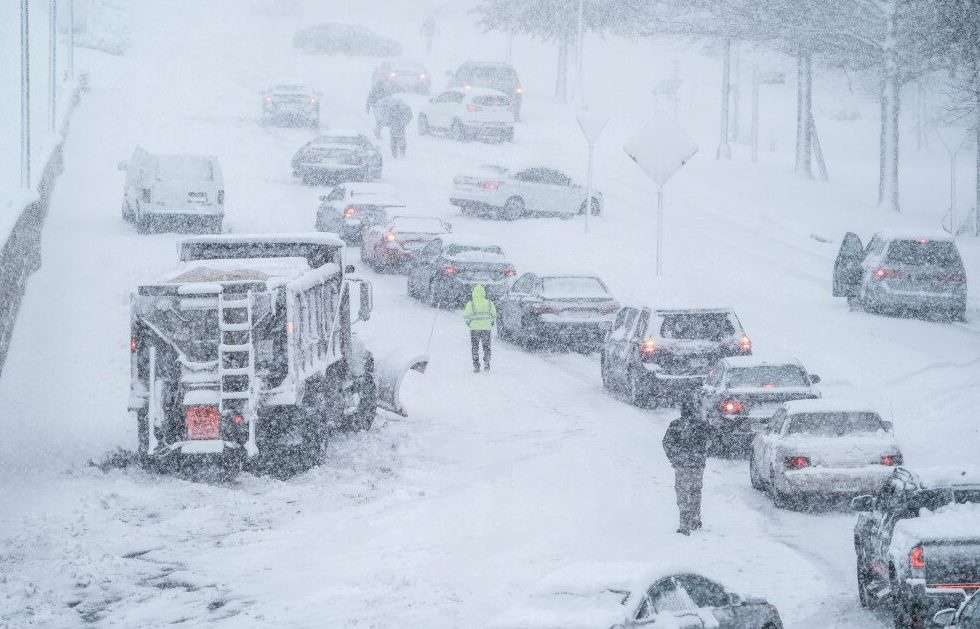Table of Contents
A powerful snow storm or winter storm is forecasted to bring heavy snowfall of 6-10 feet and strong winds to the Sierra Nevada region over the weekend. This storm is expected to block roads and isolate communities for an extended period too. Meteorologists from AccuWeather are warning of intense snowfall rates of up to 4 inches per hour and wind speeds ranging from 60 to 75 mph, creating hazardous blizzard conditions with significant snow accumulation. The peak gusts in the Sierra Nevada are projected to reach up to 90 mph.
“Donner Pass, California, along Interstate 80 and segments of I-5 in Northern California to Siskiyou Summit in southern Oregon are likely to close,” Rayno added.
The heavy snowfall rates pose a significant risk of motorists getting stranded as road crews may struggle to clear the roads until the storm subsides by the end of the weekend.
Big snowstorms and strong winds might knock out power for a long time, especially in far-off places. If you live somewhere isolated, make sure you have a good way to keep warm and plenty of food. Don’t forget to keep your chimney and furnace clean to avoid dangerous gases. Stay safe in this tough weather.
What causes snow storm?
Winter storms, hurricanes, and blizzards happen because of different weather situations. Winter storms happen when there’s low pressure over a big body of water. Hurricanes happen when there are thunderstorms over warm tropical waters. Blizzards happen when warm air hits really cold air, and then the cold air moves south.
Why are snow storms dangerous?
Snowstorms: More Than Just Pretty Snowflakes
Snowstorms might seem enchanting when you watch the delicate snowflakes fall, but they bring a host of challenges. Let’s break it down:
Safety Hazards: Snowstorms pose risks to people. Slippery roads and reduced visibility make driving treacherous, leading to accidents. Roads may close, leaving us stranded.
Travel Woes: Heavy snow can disrupt travel plans. Flights get delayed, trains slow down, and buses struggle through snow-covered streets. Imagine waiting at a chilly bus stop, hoping for a ride!
Power Outages: Snowstorms can knock out power lines. Suddenly, your cozy home turns dark and cold. No lights, no heat—just you and your flashlight.
Building Stress: Snow piles up on roofs, straining structures. Roofs can collapse, windows may break, and pipes freeze. Buildings bear the weight of winter.
School and Work Chaos: Snowstorms disrupt routines. Schools close, kids miss classes, and parents juggle work-from-home while shoveling driveways. It’s a snow-day scramble!
Essential Services Hit: Emergency services, like ambulances and fire trucks, struggle to reach people. Imagine needing help, but the snow blocks the way.
How to prepare for a snow storm?
- Food Stock-Up: Before the snow hits, grab your favorite snacks and essentials. Think comfort food soup, hot cocoa, and maybe some cookies. You are going to thank yourself later.
- Window Check: Close those windows! Seal them up tight to keep the chilly drafts out. No one wants an unexpected snow breeze while binge-watching their favorite show.
- Winter Wardrobe: Dig out your winter gear from the closet. Boots, cozy sweaters, puffy jackets, and that trusty scarf or hat—it’s time to bundle up.
- Reschedule Plans: If you’ve got appointments or events that involve more than just walking, consider rescheduling. Doctors, dates, and parties can wait until the snow clears.
- No Driving, Please!: Seriously, leave the car keys at home. Snow-covered roads turn into slippery slides.. Opt for public transport or good ol’ walking.
- Power Outage Plan: If your city’s prone to power outages, be prepared. Grab some candles (just in case) and have a backup spot to crash if the lights go out. Skip kerosene heaters—they’re more trouble than warmth. Call up a friend and camp out at their cozy place instead.
How does a snow storm formed?
- Snow Formation: When water vapor in the air cools down significantly, it transforms directly into tiny ice crystals. This is called deposition.
- Cloud Conditions: Snowflakes are born in clouds. For snow to form, the air temperature within these clouds must be no higher than -4°C (24.8°F). If the relative humidity is below 100%, meaning there’s no super-saturation, snow can take shape.
- Ice Crystal Growth: Within the cloud, ice crystals coexist with super-cooled water droplets. These ice crystals grow by siphoning moisture from the water droplets. This phenomenon is known as the Bergeron Process. The reason behind this growth is that the vapor pressure over ice is lower than over water.
- Gravity’s Pull: As the ice crystals accumulate and become heavier, they eventually succumb to gravity and fall to the ground, creating the beautiful snowflakes we see during winter.
Is it more common to have thunderstorms or snow storms?
- Thunderstorms: These electrifying events are more common in warmer and humid climates. Imagine the clash of warm, moist air from the Gulf of Mexico with cooler air from the north. That’s where thunderstorms love to dance! In the Southeast and Gulf Coast regions of the United States, lightning crackles and thunder rumbles as these storms put on a show.
- Snowstorms: Picture a cozy winter scene—snowflakes gently falling, blanketing the landscape. These chilly spectacles prefer colder and polar climates. If you’re in the northern or mountainous parts of the U.S., you’re likely to experience snowstorms. It’s like nature’s way of saying, “Time for snowball fights and hot cocoa!”
- The Intriguing Factors: But wait, there’s more! Local factors play a role too. Think topography, wind patterns, and weather systems. Sometimes, even if it’s not the usual climate, certain regions get extra thunderstorms or snowstorms. Mother Nature keeps us guessing!
- So, whether you’re chasing lightning bolts or building snowmen, remember that the frequency and intensity of these weather wonders depend on where you are. Stay curious, weather enthusiasts!

